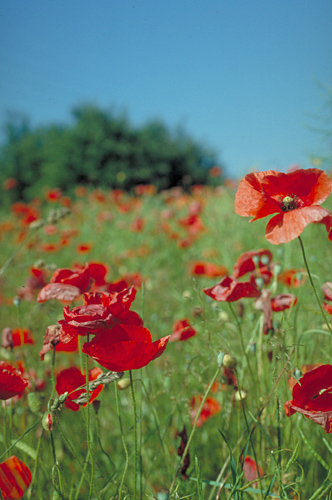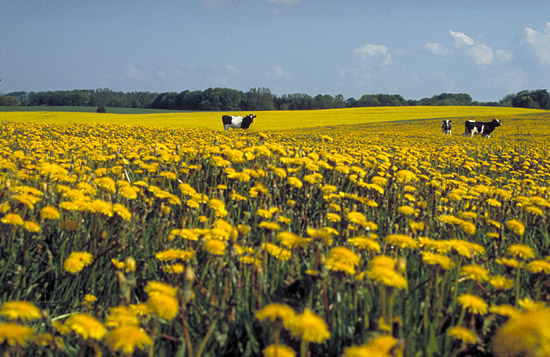Most of the weed species can grow and spread their seeds before the soil is ploughed at the end of the season. Many weeds produce a large number of seeds, which can stay dormant in the ground for several years and germinate under the right conditions mostly when exposeed to light. Other species produce long stolons etc. which quickly can produce new plants.
The species in the crop fields are distributed througout Denmark according to climate and soil properties. But he managemanet of the ground can also have a great influence on the occurence of single species.
The right picture shows that Dandelions - Taraxacum - is a very common species in grass pastures. Dandelions can spread a long distance due to their light seeds. In the background of the picture is a field of yellow flowering oilseed rape - Brassica napus - a commun sight in spring in Denmark.
 |

| The most common weeds in
the danish crop fields are Stellaria media, Chenopodium album,
Elytrigia repens, Viola arvensis, Poa annua, Cerastium fontanum ssp.
vulgare, Myosotis arvensis, Plantago major, Matricaria perforata,
Veronica arvensis, Veronica persica, Persicaria maculosa, Fallopia
convolvulus and Polygonum aviculare. Many of these species are naturally occuring on the banks of old rotting algae along the coasts where the soil is very rich in nutrients and are disturbed regularly - the same conditons as in crop fields. Elytrigia repens is a perennial while the rest are annuals. Elytrigia repens has a very extensive root systems with long stolons. Just a little piece of the stolon can grow to a new plant - a well known irritating problem for gardeners. The beautifull Papaver dubium in the left picture is particularly common in fields on lime-rich soils. |